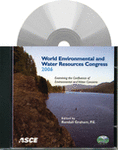Modeling of Soil Hydraulic Processes and Base Flow in Flanders
Publication: World Environmental and Water Resource Congress 2006: Examining the Confluence of Environmental and Water Concerns
Abstract
This paper presents findings from an investigation into catchment hydrological response to changing stimuli, including land use change, climate change, and river valley rewetting. It outlines the central role of groundwater modeling in the development of a physically based, fully distributed catchment model, which role was as a consequence of the stream flow composition. The paper also examines the influence of the catchment's hydraulic characteristics on the discharge. The study area was the Grote Nete catchment, located in the northeast of Belgium. Numerical digital filtration established that base flow constitutes the dominant stream flow of the river network, accounting for over 60% of the flow, followed by interflow with 25%. It was thus, considered paramount that these flow components be modeled accurately. The paper also highlights two issues that were taken into consideration when characterizing the catchment model. Firstly, the experimental procedures for measuring the soil hydraulic characteristics are difficult and not very reliable. Secondly, the use of pedotransfer functions to derive the characteristics from more easily measurable characterizing properties of the soil is equally as unreliable. The Averjanov method was used for the model. This method contains an exponent, whose value had a direct influence on the percolation rate in the soil and thereby influenced the actual evaporation rate. The MIKE SHE model code was adopted to model the temporal and spatial variability of soils. In testing the model hypothesis, the research made use of discharge data. For implementing a multi-criteria calibration protocol, a tool was sought that incorporates a recursive digital filter for exponential recessions to split total rainfall-runoff discharges into its three component sub-flows, and is able to determine the recession constants for each component. WETSPRO, a tool for time series analysis, was adopted. The catchment model is now being used to study trends of anthropogenic changes on catchment hydrology.
Get full access to this chapter
View all available purchase options and get full access to this chapter.
Information & Authors
Information
Published In
Copyright
© 2006 American Society of Civil Engineers.
History
Published online: Apr 26, 2012
ASCE Technical Topics:
- Base flow
- Bodies of water (by type)
- Catchments
- Engineering fundamentals
- Flow (fluid dynamics)
- Fluid dynamics
- Fluid mechanics
- Geomechanics
- Geotechnical engineering
- Groundwater
- Hydraulic models
- Hydrologic engineering
- Hydrologic models
- Models (by type)
- River flow
- Soil mechanics
- Soil properties
- Streamflow
- Water (by type)
- Water and water resources
- Water management
Authors
Metrics & Citations
Metrics
Citations
Download citation
If you have the appropriate software installed, you can download article citation data to the citation manager of your choice. Simply select your manager software from the list below and click Download.
